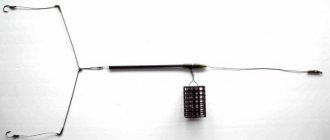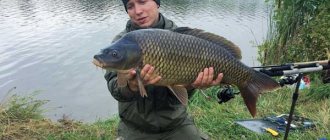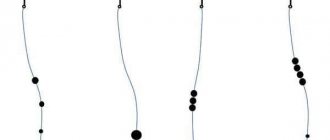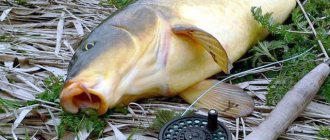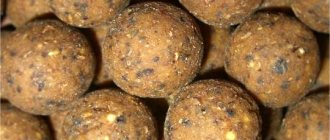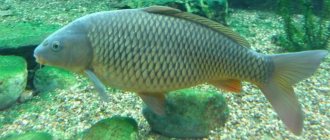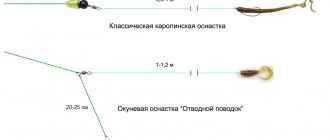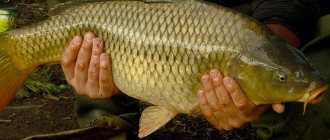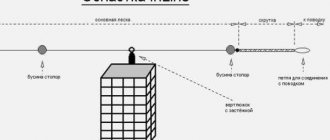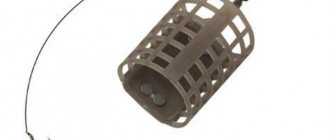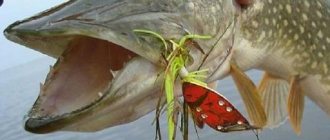In modern carp fishing, montages are the most favorite topic. Which installation to choose, how to attach the equipment to the hook, and so on. We present a short guide-memo about the ten most popular and effective carp rigs. The main thing you must remember is that in carp fishing there are only three options for presenting bait - bottom, floating (when the hook also floats) and critically balanced (when the hook lies on the bottom, but the bait floats). The method of feeding the bait, using one or another leash, is dictated by the nature of the bottom in which the fishing will be carried out. Below are short, clear instructions on which leash to choose in a given situation and what is required to knit a standard leash of each type.
Chod rig
Briefly about the equipment: today the Chod Rig is definitely more popular among English fishermen than the Beckham family. Its meaning is that short, very stiff monomaterial frightens the carp, which makes a sharp movement away from the leash, and here an aggressive bend of the leash comes into play. It seems to the carp that it is saving itself, but in fact this sudden movement is destructive. The result is a serif and a very deep one.
Where to use: You can fish on any bottom, but it’s most effective to use a chod rig on top of grass, deep silt, or on areas of the bottom contaminated with debris.
Nozzle: pop-up only. The best thing is a pop-up with a cork ball inside. If you use a regular pop-up, be sure to check in a jar of water that it lifts the leash.
Components: Rigidity material 30lb, Stif Rigger hook, ring
Carp equipment
All carp rigs can be distinguished by the following criteria:
- According to the type of weight used (regular weight, feeder).
- According to the type of installation (blind, sliding).
- According to the type of bait holding (floating, sinking).
- According to the position of the leash.
The type of equipment should be used depending on the fishing conditions.
Nodes
Typically, equipment for catching carp includes the following components:
- braided fishing line;
- monofilament
In order for such fishing lines to hold all the gear well, it is necessary to use the strongest possible knot.
Based on the required purposes, the following components can be used for equipment:
- Making a loop. A paired knot and a surgical loop are used.
- Knot for attaching hooks and boilies. To make it, you need to tie a loop at the end of the leash, and then tie a so-called knotless knot on the hook.
- Knots for attaching leashes to the main line. For such purposes, you need to use the “Palomar”, “Grinner” or “Clinch” knots.
- For fastening monofilaments, Albright type knots are used.
- To attach monofilament to a shock dealer, knots such as “Carrot”, “Grinner” and “Uni” are used.
Hooks
The main requirements that hooks must meet are to be very strong and sharp. They should easily enter the carp lip and hold the fish tightly, while preventing breakdowns.
When purchasing a hook, a fisherman must know exactly what kind of fish he will use it on, and depending on this, choose the size and type of hook.
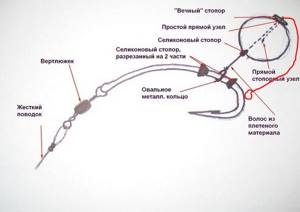
According to their shape and bend, hooks are:
- The eye of the hook “looks” towards the inside. Such hooks can be used for almost all carp rigs. The sting in such hooks is wrapped towards the eye, while it easily unfolds in the carp’s mouth and deftly hooks the fish, preventing it from dodging. Hooks of these shapes always have a very long, straight shank.
- The eye of the hook “looks” outward. Such hooks are used together with rigid leashes.
- Hooks with a straight eye are used to catch carp fish in the uppermost water levels. In this case, the hook should be installed on top of the bait so that the fish that swims up from the bottom area cannot see it.
- Hooks with a straight eye and a concave fore-end. Such hooks are used for catching very large carp, since they detect the fish very quickly, preventing it from escaping.
Leashes
For leashes, you can use different types of fishing lines. The length of the leashes can also vary. It depends on the fishing conditions.
According to their variety, leashes are:
- hard;
- compound;
- soft;
- combined.
Rigid fishing line leash
To construct rigid leashes, you should use a mono line with a very large diameter or a special line that is designed for leashes. Rigid leashes are convenient because they prevent the carp from spitting out the hook, so it cannot fall off it.
The main disadvantage of such leashes is that they do not lie “naturally” on the bottom. Such leashes are secured with a loop, which gives them some freedom of movement.
Composite leash made from fishing line
Composite leashes are made from two different lines. The main part of the leash is made of rigid mono or florocarbon fishing line. The additional part of the leash is made of soft braid. Both sections of fishing line are fastened using an Albright knot or a swivel.
Soft leash
Soft leashes are made from soft braided fishing line. They are used when the fish bites well and swallows the bait right on the fly.
Due to the fact that the leash is very soft, the carp does not pay attention to it and is not afraid, but at the same time, such a leash is more susceptible to tangling and overlapping than others.
Combined leash
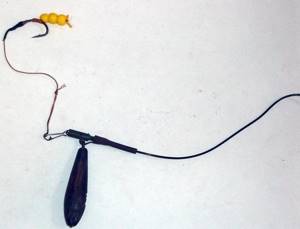
A combined leash is made from two pieces of soft and hard fishing line. The soft part is located at the hook, and the hard part forms the basis of the entire leash. This manufacturing technique makes it possible to prevent tangling of the fishing line, which often happens with leashes made from soft fishing line.
In addition, it is the soft part of the fishing line that will not scare away the fish as much as the hard one, which is why combined leashes are increasingly gaining popularity.
Withy Pool Rig
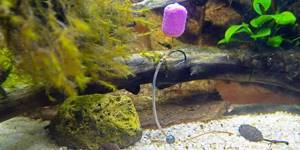
The rig in a nutshell: The long, curled section of heat shrink tubing provides an incredibly aggressive angle of attack and increases the hook's hooking potential severalfold.
Where to use: in principle, can be used on any type of bottom
Nozzle: pop-up only
Ingredients: Withy Pool extension, soft lead, hook stopper, SSC hook
Standard leash
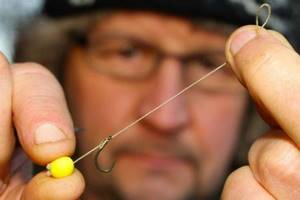
Briefly about the equipment: the simplest hair installation, which everyone learns to knit first, still remains effective and should in no case be neglected. Countless fish have been caught, are being caught, and will be caught.
Where to use: Can be used on any day. The only thing you need is to choose the length of the leash and the length of the hair for your specific conditions. In some places the fish like longer ones, in others they like shorter ones. Try it, because no two bodies of water are the same.

Nozzle: you can use a bottom rig; in the case of a pop-up, it will need to be loaded with pellets or soft lead or pop-up sinkers. A critically balanced attachment can also be used
Components: leader material, boilie stopper, silicone on the hook, Cryogen Classic hook, sinker for pop-ups
Fluorocarbon leaders
Fluorocarbon leashes are an excellent solution for catching carp, since this material, when it gets into the water, becomes almost invisible to this cautious fish.
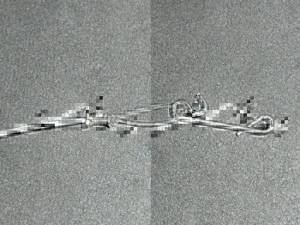
Fluorocarbon leashes have the following advantages of their use:
- They are invisible in water.
- Very resistant to abrasion and rubbing.
- Fluorocarbon leaders are stiffer than monofilament.
- They withstand various deformations better.
- Even after repeated tying, fluorocarbon looks much straighter than mono fishing line, since it has a low memory for remembering bends.
To install leashes made of fluorocarbon fishing line, the following components should be used:
- clasp;
- swivel;
- driving material.
This leash is knitted as follows:
- Make a regular single knot at the tip of the fluorocarbon and tighten it a little (but not completely).
- Insert the other tip of the driving material into this knot.
- Using a lighter, slightly fuse the edge of the fluorocarbon so that a certain build-up appears. This will give the future leash more strength.
- Place a swivel on the leash.
- Take the cord. Tie a regular loop on it.
- Pull the other end of the cord into it and make a noose loop.
- Pressing this loop, wind the fishing line in tight turns.
- After you wind the line to the end, you need to turn the line around and wind it in the opposite direction.
- Tie a strong knot at the end.
- After this, you need to fasten the finished leash with the rest of the equipment.
PVA bag
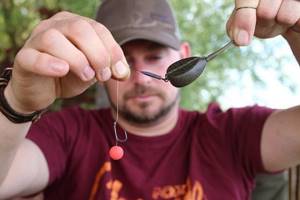
Briefly about the rig: this rig uses only soft braided material 8-10cm long, coupled with an inline sinker. The PVA bag serves as a real bait bomb for carp, because due to the low consumption of bait, you can use the most expensive and high-quality batteries. To fill the PVA bag you will need a bulk component, you can use a stick mix or just bait, as well as small pellets. Plus add some liquid, at least hemp oil.
Where to use: Best for use on hard, clean bottoms.
Bait: It's best to use small baits, whether pop-up or sinking, but pop-ups are preferable to lift the leader above the sinker and bait. The critical balanced nozzle is also a great option.
Components: material without braid, hook No. 8 Cryogen Classic, stopper for the nozzle,
Types of carp leashes
- Pop-up leashes are suitable when it is necessary to suspend them above the bottom level. When catching carp in reservoirs with a muddy, littered bottom, it is better to use wicker materials or durable opaque elastic polyethylene for fishing line. The leashes are buoyant and stable on the water. Only under such conditions can such equipment be considered high quality.
- Neutral . Convenient for fishing and inconspicuous in reservoirs with dense vegetation. Not suspicious for cyprinids, since they do not sink or float, they will take a neutral position at the desired water level.
- Sinking , when adjacent to the bottom, will become invisible even to the most careful individuals, since they will be compatible in color. But such leashes are only suitable for a clean bottom. If there are uneven spots, snags are possible and when fishing, the carp may simply spit out the bait and swim away. Before using sinking leaders, it is advisable to first examine the bottom. It must be clean, otherwise fishing will not be effective.
- Invisible fishing rods are recommended for use in clear waters with a clean bottom, when all other leads have already been studied by the carp and are noticeable to it. The fish no longer wants to swim to the desired fishing spots.
- Hard ones are applicable if carp get used to soft leashes and there have been cases of them snacking. If the leader is stiff, it will be more difficult for the fish to break off the hook. To attach it to the equipment, the “loop” method is used. The movement of the leash becomes freer.
Strong, wear-resistant and elastic leashes are the best and most popular models, suitable when placed near reeds or for fishing in reservoirs with dense vegetation.
Blowback rig
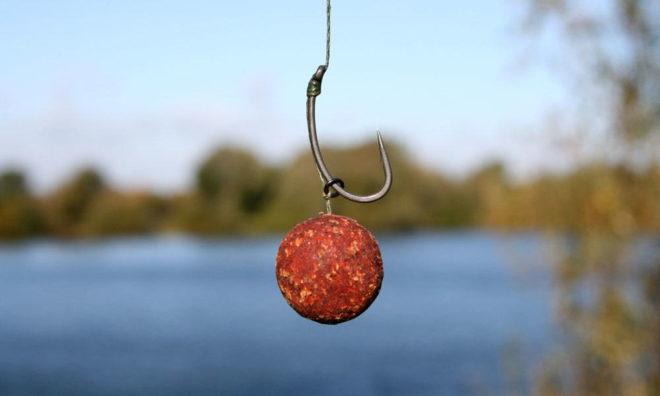
Briefly about the equipment: this equipment differs in that a ring is tied to the hair on the shank of the hook opposite the sting. This type of rig increases the speed at which the hook turns, and it bites into the carp’s lip faster.
Where to use: clean hard bottom - make the hair shorter; if the bottom has grass or shallow silt - increase the length of the hair
Nozzle: the best option is a snowman
Components: soft braided leader material, ring, Cryogen Gripper hook
DIY carp leash
There are several known types of leashes that differ from the material used. When making them, you need to take into account the fishing conditions, the nature of the bottom, the presence or absence of vegetation in the water.
Made from soft woven material
This leash is easy to make, it turns out soft and elastic, and the bait is delicately brought to the carp. The soft braid is practically not felt when biting. But the hair can quickly twist, get tangled during sharp casts, and is not resistant to cuts.
The scope of application of such a leash is limited. It is applicable only if there is a clean and hard bottom, without shell shells, vegetation, snags and stones.
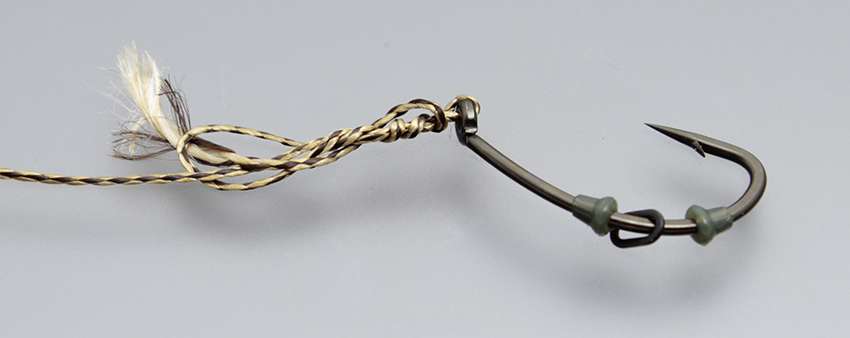
To make it you need:
- take the leader material, tie a long loop on it so that you can hide the knot inside the nozzle;
- cut a piece of braid to the required length;
- place the boilie on the loop and stop;
- fix the nozzle by installing a silicone stopper at the bottom;
- put a silicone tube (3 mm in diameter) on the leash and pass it through the sting;
- adjust the hair length, tie the hook, tie it in a knot, tighten;
- check the leash to see how it clings;
- if it is too tenacious, glue the knot;
- equip the leash with a silicone remover to prevent tangling;
- Attach the leash to the tackle, install it to fix it in the place where the diverter is attached.
Made of woven material with a protective sheath
The material is a soft braided fishing line, placed in a plastic shell to protect the leash from possible breaks (cuts). Using a similar model, fishing is possible in snags, in quarries with stones or gravel at the bottom. To prevent it from deforming, you need to constantly keep it stretched and place it only on rigid leads.
A sheathed braided leash will not get tangled even when casting with force, but it is difficult to manufacture and transport.
To install a braided leash in a shell you need:
- remove the sheath from the leash in an area the size of the hair length, but first measure the attachments, which will need to be installed later when assembling the equipment;
- tie a loop;
- cut the braid to the required length, attach the boilie;
- attach a silicone stopper at the bottom;
- put on the tube, pass it through the sting, then onto the hook;
- adjust hair length;
- tie the hook in a knot, tighten;
- adjust hair length;
- glue the knot if the hooks are too tenacious;
- bend the heat shrink tube, the end of which should be adjacent to the hook tip
- put on the diverter or fix the leash on the hook with a swivel, tie it to the ring to obtain a swivel joint;
- attach to the equipment by tying a loop.
Fluorocarbon
The peculiarity of such models is the use of materials of different hardness. The part of the tackle next to the sinker needs to be made more rigid by using fluorocarbon or icecore. The remaining parts of the leash can be made of softer material. Such leashes are invisible to fish.
The rigidity of the material will not allow twisting and gathering into an accordion when lowering to the bottom, and there will be no overlaps when casting.
But fluorocarbon is not cut-resistant, and this is its significant disadvantage. For installation you need:
- cut off a piece of soft material, tie a loop;
- plant the boilie, stop;
- equip the lower part of the fishing line with a silicone stopper;
- tie a steel ring up to 0.2 mm in diameter to the hair;
- thread the hook into the ring and tighten the knot;
- check the hook for grip on the palm;
- adjust the location of the ring on the hook, glue the knot if necessary;
- tie the soft part of the tackle with fluorocarbon in a knot, glue it, singe the knots with a lighter;
- put on the diverter, make a loop on the other rigid part;
- At the junction of two different materials, for strength and to avoid tangling when casting, glue a piece of soft lead or attach a steel weight to limit the height of the nozzle.
This will make the leash durable. The hair attached to the steel ring will move freely along the shank of the hook. Even when spitting out the bait, if it gets pricked on the hook, the ring will quickly move down and the hook, being free, will pierce the fish’s lip quite deeply.
Combi rig
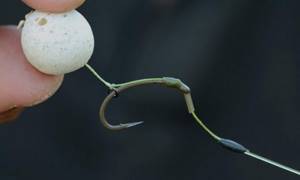
Briefly about the equipment: fluorocarbon leader, which is connected to soft leader material. The bottom line is that the fluorocarbon pushes the rig as far away from the sinker as possible, and the soft leader material ensures perfect presentation. The nozzle is movable and behaves very naturally. Using a combi-rig, our Carptoday team won more than one tournament in 2015, including the Moscow Cup!
Where to use: clean hard bottom
Bait: It is best to use a bottom boilie with a pop-up cap or plastic corn attached.
Components: Fluorocarbon material, non-braided material, heat shrink tubing, soft lead, Cryogen Gripper hook
Neutral leashes
As you can guess from the name, leashes of this type have neutral buoyancy, because The density of water and the leash material are the same. Leashes with neutral buoyancy have proven themselves excellent when fishing in weeds. In such an environment they look natural, unlike other carp fishing leaders.
If we talk about choosing the length of leashes, then there are many factors to consider, such as:
- size of the expected catch,
- feeding environment,
- fish behavior that is determined by a particular situation.
- fishing distance or casting distance
In general, the leash should be long enough so that the carp can get hooked before it spits out the bait.
When choosing the length of a leash for carp fishing in specific conditions, you need to keep the following in mind: long leashes are less alarming to the carp, but provide it with more time to free itself from the bait with the hook, until the latter properly pierces the lip due to the weight of the sinker. In this case, you most likely will not even know that the carp has tried your bait, since the sinker remains in place. A short leash transmits a bite almost immediately, because in order to move the sinker the fish does not need to move, it is enough to simply raise its head, taking a horizontal position. On the other hand, a short leash will scare the fish faster, and if the carp senses danger before it pricks the hook, it will simply spit out the bait. High-quality self-hooking will occur when a correctly tied leash has an optimal length that corresponds to specific fishing conditions.
Articulated Stiff rig
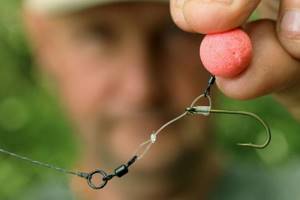
Briefly about the rig: one of the most popular rigs today after the Chod Rig. The idea is that you take a section of chod rig and tie braided leader material to it. This ensures that the bait moves away from the leadcore and sinker. We also note that it is better to make a large loop of 4 cm - this will ensure the mobility of the chod section, which will have a beneficial effect on the naturalness of the equipment.
Where to use: on a clean bottom.
Nozzle: strictly pop-up.
Components: matte material, chod-riga section (see above)
Multi rig
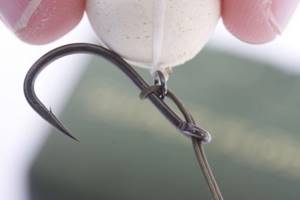
Briefly about the equipment: its main feature is that you can change the hook in the blink of an eye. Moreover, you do not make blanks in the form of leashes, but you make blanks in the form of swivels with an attachment, which you then put on the hook. Very low consumption of leader material, very quick replacement of hook and nozzle.
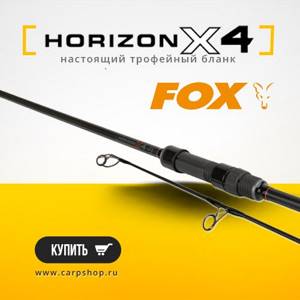
Where to use: Can be used anywhere, even in the grass. If you fish on a muddy bottom
Bait: It is better to use a pop-up, loaded with soft lead or a pop-up sinker. But you can also use a sinking boilie. Experiment!
Components: braided material, micro swivel, soft lead, SSBP hook
Line Aligner Installation
The installation of this equipment should place the sting and fishing line on the same line, which, when pulled, turns the hook in the carp’s mouth so that it is completely inserted behind the fish’s lip.
If the hook has a short tip, then you should use a plastic heat shrink tube, which will make it longer and make it possible to make a full turn.
Manufacturing
To make this leash, you need to use a small piece of rigid plastic tube, the size of which will be no more than one hundred and fifty millimeters. Its diameter should be slightly larger than the diameter of the hook used.
- At the very tip of the leash, tie a loop, which will be needed to hold the boilie on the leash.
- Tie a knot in the middle of the hook shank.
- Tie two more knots near the eye of the hook and then thread the leader through the eye of the hook.
- Thread the leash into the plastic tube.
- Pull the tube onto the hook so that its tip is flush with the hook's point line.
Installation for maggots
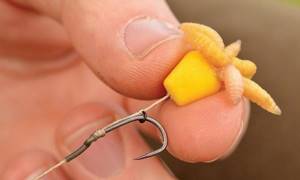
Briefly about the rig: there is a trick to this rig - using a match hook at the end of the hair on which you will attach maggots. The hook itself is covered with plastic corn. There is also a ring for a blowback effect. In short, this is one of the most beautiful and catchy montages
Where to use: everywhere except areas with grass. Works well when fishing near mud
Nozzle: maggots and plastic
Components: read our detailed article about this equipment
What gear are leashes attached to?
- spinning;
- fly rod;
- match rod;
- balonese;
- float tackle;
- fly rod;
- girder;
- mugs.
Under what circumstances is it appropriate to use them? Firstly, when fishing in an area without algae or when catching cautious fish - for the sensitivity of the bite and the invisibility of the gear. Secondly, when catching medium-sized fish and when the bite is sluggish, it is more convenient to hook with thinner equipment. Thirdly, to avoid breaks in the main line in rocky and vegetative areas.
For fans of feeder fishing, it will be interesting to read an article from the magazine “Sports Fishing” entitled “Classic and modern English donka. Feeder leash assembly" https://sfish.ru/page/klassicheskaja-i-sovremennaja-anglijskaja-donka-fidernyj-povodok-v-sbore
For fans of sea fly fishing, the article “With fly fishing in the Black Sea” (magazine “Sports Fishing” https://sfish.ru/page/s-nahlystom-v-chernom-more) will be of interest
